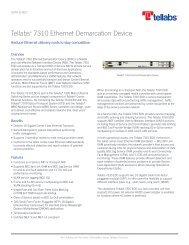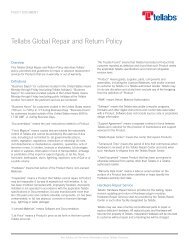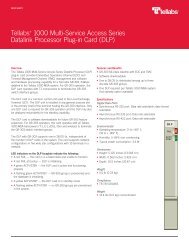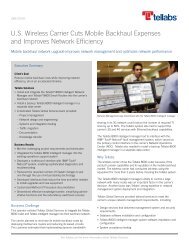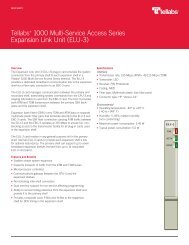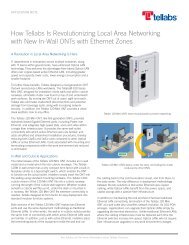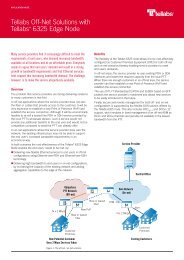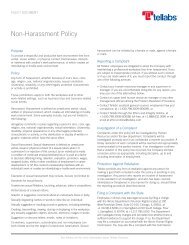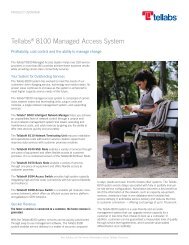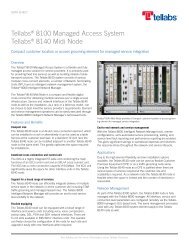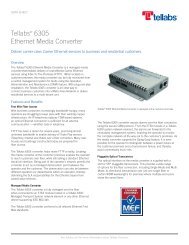Expanding SON into the Mobile Backhaul Network from our ... - Tellabs
Expanding SON into the Mobile Backhaul Network from our ... - Tellabs
Expanding SON into the Mobile Backhaul Network from our ... - Tellabs
You also want an ePaper? Increase the reach of your titles
YUMPU automatically turns print PDFs into web optimized ePapers that Google loves.
WHITE PAPER<strong>Expanding</strong> <strong>SON</strong> <strong>into</strong> <strong>the</strong> <strong>Mobile</strong> <strong>Backhaul</strong> <strong>Network</strong>Even though customer demand for mobile bandwidthcontinues to increase exponentially with no signs of stopping,network operators still have to find ways to cut operationalcosts to remain profitable. It’s an age-old dilemma: How cana service provider reduce operational expenses while stayinginnovative and keeping <strong>the</strong> customers happy?One solution for mobile network operators lies in self-organizingnetworks (<strong>SON</strong>s). <strong>Mobile</strong> radio equipment manufacturersbegan building <strong>SON</strong> standards <strong>into</strong> <strong>the</strong>ir products in 2009.Since <strong>the</strong>n, network operators have begun incorporating <strong>SON</strong>technology <strong>into</strong> <strong>the</strong>ir radio access networks (RANs) in aneffort to increase automation, reduce capital and operationalexpenses (CapEx and OpEx), and improve quality of service(QoS). These operators are realizing quantifiable savings,including reduced maintenance costs and improved servicedelivery intervals. <strong>SON</strong> is a key concept in Long Term Evolution(LTE) networks. <strong>Mobile</strong> operators are applying <strong>SON</strong>first in LTE mobile RANs and standards are specified first forLTE simply because base stations account for such a largepart of <strong>the</strong>ir expenses.Operators have a significant opportunity to expand <strong>SON</strong>, notonly <strong>into</strong> 2G and 3G RANs, but also <strong>into</strong> mobile backhaulnetworks. This white paper takes a brief look at <strong>the</strong> successof <strong>SON</strong> in LTE networks and explores how <strong>the</strong> concept can beextended to backhaul networks. It will discuss <strong>the</strong> drivers for<strong>SON</strong> in <strong>the</strong> backhaul network and examine at a high level how<strong>SON</strong> can be implemented beyond <strong>the</strong> mobile RAN.Explosive Growth in <strong>Mobile</strong> Traffic Demands AutomationIn recent years demand for mobile connectivity, particularly dataservices, has exploded. By some industry estimates, mobile datatraffic in 2011 was about eight times <strong>the</strong> size of <strong>the</strong> entire globalInternet in 2000. According to an independent research andconsulting firm Infonetics Research:• The number of mobile phones is on track to exceed <strong>the</strong> globalpopulation by 2016• Data traffic, driven largely by IP video, is growing at 40% to 100%a year;• And yet, 2011 average revenue per user fell in every region of <strong>the</strong>globe. 1Increasing demand combined with decreasing revenue makesreducing operating costs even more crucial for network operators.<strong>SON</strong> can help operators reduce costs by increasing automationwhile providing <strong>the</strong>m control over when to use that automation. Italso makes networks easier to plan, deploy, optimize and maintain.<strong>SON</strong> with <strong>the</strong> goal of increasing automation is not new. However, <strong>the</strong>standards for implementing <strong>the</strong> technology are a relatively recentdevelopment. In <strong>the</strong> LTE concept, <strong>SON</strong> was first highlighted as acrucial capability in 2006 by <strong>the</strong> Next Generation <strong>Mobile</strong> <strong>Network</strong>sAlliance (NGMN). Since <strong>the</strong>n, <strong>the</strong> Third Generation Partnership Project(3GPP) has been developing specific <strong>SON</strong> standards with Releases8, 9 and 10 providing specifications for mobile equipment vendors.In <strong>the</strong> RAN, base station installation and maintenance is a goodexample of how a network operator can use <strong>SON</strong> to reduce OpEx. Ina typical RAN, operators need highly skilled, well-trained engineersusing specialized toolsets to install and commission base stations.Every time a problem occurs with <strong>the</strong> installation, that skilledengineer may need to visit <strong>the</strong> cell site again to diagnose and correct<strong>the</strong> problem. As a result of an additional site visit, <strong>the</strong> operatoralmost doubles <strong>the</strong> site-related installation expenses. Clearly, innetworks where cell sites are multiplying – yet shrinking in size – onsiteengineer visits are not only cost-prohibitive, but also introducingsignificant delays to <strong>the</strong> rollout program and time to revenue.With <strong>SON</strong>, a technician can install equipment at <strong>the</strong> cell site. Afterthat, it can be configured <strong>from</strong> an operator’s central location usingautomatically established connections to <strong>the</strong> operation supportsystems as well as automatic configuration and au<strong>the</strong>nticationfeatures. This capability reduces training time for technicians,eliminates <strong>the</strong> potential for human error, and cuts <strong>the</strong> time it takes toturn up new sites. In addition, <strong>SON</strong> offers full potential for reducingenergy consumption through automatic turn off features of selectedsites, which should serve only atspecified busy h<strong>our</strong>s.Companies like Ericsson and Nokia Siemens <strong>Network</strong>s (NSN) begandelivering <strong>SON</strong>-capable mobile radio equipment in 2009, andnetwork operators already have begun to reap <strong>the</strong> benefits. Ericssonestimates that <strong>SON</strong> features have resulted in 40% faster rollouts,and as much as a 90% reduction in daily maintenance for new LTEnetworks among its customers. 2 Similarly, NSN’s network operatorcustomers, who are using <strong>SON</strong> to balance network congestion in <strong>the</strong>RAN, have seen a dramatic reduction in <strong>the</strong> number of dissatisfiedcustomers — down to just 2% <strong>from</strong> 10%. 31“Fundamental Telecom and Datacom Market Drivers Biannual Analysis of Global and Regional Market Trends and Conditions, June 14, 2012,” Infonetics Research,http://www.infonetics.com/cgp/lp.asp?id=6352Ericsson white paper, “Smarter Self-Organizing <strong>Network</strong>s,” p. 3, http://www.ericsson.com/res/docs/whitepapers/WP-Self-Organizing-<strong>Network</strong>s.pdf3Nokia Siemens <strong>Network</strong>s white paper, “Self-Organizing <strong>Network</strong>,” p. 8, http://www.nokiasiemensnetworks.com/sites/default/files/document/son_white_paper_online.pdfSee tellabs.com for more information about <strong>Tellabs</strong> Solutions
2 EXPANDING <strong>SON</strong> INTO THE MOBILE BACKHAUL NETWORKServiceprovisioningServicedefenitionServicetesting<strong>Network</strong>res<strong>our</strong>ceallocation24hr supportand reporting(SLAs)<strong>Network</strong>building anddocumentationServicechanges<strong>Network</strong>optimizationand planning<strong>Network</strong>faults andperformanceFigure 1: <strong>Network</strong> and service life cycleThe Need for <strong>SON</strong> in <strong>the</strong> <strong>Backhaul</strong> <strong>Network</strong>With <strong>the</strong> demand for bandwidth growing exponentially in mobilenetworks, <strong>the</strong> backhaul network easily becomes <strong>the</strong> bottleneck for<strong>the</strong> increasing voice, data and video traffic. At <strong>the</strong> same time, <strong>the</strong>transition <strong>from</strong> TDM to packet technologies, with <strong>the</strong> aim to drive <strong>the</strong>cost per bit down, has increased <strong>the</strong> backhaul network complexity.Increased complexity is most certainly taking a toll on <strong>the</strong> mobileoperator’s ability to remain profitable. Under <strong>the</strong>se conditions it ischallenging for network operators to roll out LTE networks and increase<strong>the</strong> backhaul capacity quickly enough to keep up with customerdemand as well as to do that in economically sustainable manner.The network and service life cycle consists of various and oftencomplex operational tasks, which need to be efficiently managedby <strong>the</strong> operator. The operational side is even more essential andcritical in <strong>the</strong> access networks, where <strong>the</strong> number of elements is ashigh as tens of thousands of devices, and <strong>the</strong> need for changes andadjustments is regular.Most of <strong>the</strong>se tasks, starting <strong>from</strong> network planning and deploymentto service creation, updates, maintenance and reporting, need tobe linked toge<strong>the</strong>r so that <strong>the</strong> operator has constantly an up-to-dateunderstanding of <strong>the</strong> network status at all levels. The main phasescould be outlined as follows:• Service provisioning and change management as frequent andtime-consuming processes call for intelligent and easy to usemanagement tools to minimize <strong>the</strong> time to revenue• Service testing and verification ensure <strong>the</strong> service meets <strong>the</strong>expectations before it is handed off to use• Reporting as part of <strong>the</strong> service delivery and network maintenanceprovides <strong>the</strong> relevant and accurate data on <strong>the</strong> network andservice performance• Fault and availability management focuses on keeping <strong>the</strong>network operational in all conditions and speeding up possibletroubleshooting activitiesNow that <strong>the</strong> <strong>SON</strong> is being defined for <strong>the</strong> radio networks toautomate <strong>the</strong> functions at <strong>the</strong> base station sites, it solves only onepart of <strong>the</strong> overall challenge. In order to get <strong>the</strong> full benefits of <strong>the</strong><strong>SON</strong>, both radio and backhaul pieces must be considered. Thisdrives <strong>the</strong> need to expand <strong>the</strong> <strong>SON</strong> <strong>from</strong> radio network to backhaulas well.Overall, <strong>SON</strong> could be considered as an additional intelligenceto traditional network management concentrating on automatingrepetitive and routine tasks, which represents <strong>the</strong> most significantpart of <strong>the</strong> daily operational work.• <strong>Network</strong> planning, building, topology management anddocumentation play an important role in <strong>the</strong> network deploymentand expansion phasesSee tellabs.com for more information about <strong>Tellabs</strong> Solutions
3 EXPANDING <strong>SON</strong> INTO THE MOBILE BACKHAUL NETWORKRadio<strong>SON</strong><strong>Backhaul</strong>1Connection23<strong>SON</strong> helps operators to:• rollout networks fast• manage bandwidth efficiently• identify and remove bottlenecks accurately• maximize capacity through intelligent and automatic trafficengineering<strong>SON</strong>, as part of a broader smart backhaul solution, can providepowerful analytics that enable delivery of <strong>the</strong> right bandwidth to <strong>the</strong>right users at <strong>the</strong> right time. Adding all this kind of intelligence andautomation can reverse <strong>the</strong> trend of declining profits.Implementing <strong>SON</strong> in <strong>the</strong> <strong>Backhaul</strong> <strong>Network</strong>Applying <strong>SON</strong> in <strong>the</strong> backhaul network will help operators reduceboth CapEx and OpEx. On <strong>the</strong> CapEx side, <strong>the</strong> potential to savemoney comes <strong>from</strong> better network planning. And more efficientdeployment, optimization and network utilization will help reduceOpEx. Implementing <strong>SON</strong> in <strong>the</strong> backhaul network requires <strong>the</strong>mobile operator to use a <strong>SON</strong>-capable network managementsystem (NMS) toge<strong>the</strong>r with smart network elements, which provide<strong>the</strong> possibility to integrate information <strong>from</strong> <strong>the</strong> RAN network forpowerful analytics.<strong>SON</strong> framework in mobile backhaul contains f<strong>our</strong> main areas,which are:• planning• deployment• optimization• maintenanceFigure 2: <strong>Expanding</strong> <strong>the</strong> <strong>SON</strong> <strong>from</strong> radio network to backhaul<strong>Network</strong> Planning<strong>Network</strong> planning is one of <strong>the</strong> most challenging tasks for mobileoperators. Adding intelligence and automation to <strong>the</strong> process resultsFigure 3: Self Organizing <strong>Network</strong>s for mobile backhaul frameworkin faster network and service build-out, lower maintenance costs,and a reduction in human error. Taking a <strong>SON</strong>-capable backhaulsolution <strong>into</strong> use, operators can preplan network elements, topology,connectivity and services, and store all potential configurations in<strong>the</strong> network database. Then, once operators install <strong>the</strong> networkelements, <strong>the</strong>y can easily upload <strong>the</strong> configurations <strong>from</strong> <strong>the</strong>database to network elements. This makes <strong>the</strong> installation processmore dynamic and flexible. This way <strong>the</strong> hardware installation andnetwork configuration processes can be managed independently,which offers greater flexibility and more room to optimize.An example of using <strong>SON</strong> for network planning might include usinga network management system to automatically assign IP addressesin <strong>the</strong> network. Automation of this function decreases <strong>the</strong> amount ofinstallation time of network elements, and eliminates <strong>the</strong> possibilityof human error. This is crucial in a complex packet-based network,where an error such as an entry of a duplicate IP address couldgo unnoticed until a service outage makes <strong>the</strong> problem apparent.<strong>SON</strong> can additionally help <strong>the</strong> operator to dimension <strong>the</strong> backhaulnetwork based on intelligent planning functions. As an output<strong>from</strong> <strong>the</strong> planned network configuration or bandwidth updates,<strong>the</strong> operator may, for instance, get an accurate list of <strong>the</strong> needednetwork elements and configurations, which speeds up <strong>the</strong> orderingprocess and delivery times.DeploymentA <strong>SON</strong>-capable backhaul solution can also help mobile operatorsdeploy network elements and provision services more quickly.According to one European operator, <strong>the</strong> plug-and-play deploymentmodel in RAN resulted in major improvements in network roll-outwhere <strong>the</strong> time to deploy a site improved <strong>from</strong> 2-3 h<strong>our</strong>s down to10-15 minutes. This not only enables bringing <strong>the</strong> individual site upand running more quickly, but also expands <strong>the</strong> network coveragerapidly as more new sites can be installed per day with <strong>the</strong> sameres<strong>our</strong>ces. With <strong>the</strong> aim to minimize OpEx, operators often outs<strong>our</strong>ceinstallation to third parties, which makes it even more important for<strong>the</strong> process to be easy and independent of special tools and expertise.See tellabs.com for more information about <strong>Tellabs</strong> Solutions
4 EXPANDING <strong>SON</strong> INTO THE MOBILE BACKHAUL NETWORKPlug-and-play installation and operator configurable workflowwizards in <strong>the</strong> NMS can deliver a streamlined process forintegrating network element discovery, interface configurations,and connectivity provisioning <strong>into</strong> seamless, automated workflow.This process can be used to automate installation of thousands ofbackhaul network elements, which reduces <strong>the</strong> need for specializedoperations personnel, and enables faster network rollout. Sincemanual coordination can be avoided, <strong>the</strong> installation time can becut <strong>from</strong> days to minutes and manual errors eliminated. Also, <strong>the</strong>installation personnel do not need any special skills or tools whichenable easy task outs<strong>our</strong>cing. The configuration set-up can ei<strong>the</strong>rbe fully automated with no user involvement or semi-automatic if <strong>the</strong>network operator prefers to maintain control over certain aspects of<strong>the</strong> installation process.In addition to using <strong>the</strong> wizard features of a <strong>SON</strong>-capable backhaulsolution to automatically install and fully configure a networkelement in <strong>the</strong> backhaul network, <strong>the</strong> operator could also use suchfeatures to test <strong>the</strong> connectivity to <strong>the</strong> cell site and ensure that trafficdelivery is meeting service-level agreement (SLA) requirements. Thistest and verification task would optimally be part of <strong>the</strong> installationprocedure. Moreover, as part of <strong>the</strong> deployment workflow, <strong>the</strong>operator may choose to discover neighboring network elements,and if needed to update software versions on various networkelements in <strong>the</strong> backhaul network. As part of <strong>the</strong> deploymentprocess, <strong>the</strong> NMS could <strong>the</strong>n send a short message service (SMS)text or an email to <strong>the</strong> technician indicating that <strong>the</strong> installation wassuccessful, and that traffic is being delivered. This eliminates <strong>the</strong>need for consecutive site visits, which are major OpEx contributors,and culprits for project delays.This kind of deployment automation will undoubtedly lead toquantifiable savings in <strong>the</strong> backhaul network. With networkoperators reporting that <strong>SON</strong> in <strong>the</strong> RAN results in 40% fasterrollouts, and as much as a 90% reduction in daily maintenance fornew LTE networks, it’s a safe bet that similar results can be achievedin <strong>the</strong> backhaul portion of <strong>the</strong> network.OptimizationFor network operators to realize operational savings in <strong>the</strong> backhaulnetwork, network and service delivery optimization is essential.A <strong>SON</strong>-capable backhaul solution can help operators to manageoperating costs and bandwidth, and in addition use <strong>the</strong> availablebandwidth in <strong>the</strong> most efficient and fair manner.The <strong>SON</strong>-capable backhaul solution can deliver very accuratenetwork utilization and traffic trending reports, which operatorscan use to monitor <strong>the</strong> health of <strong>the</strong> backhaul network, and predictpotential bottlenecks before <strong>the</strong>y occur. Thanks to automaticcorrelation of <strong>the</strong> backhaul network analytics with <strong>the</strong> informationga<strong>the</strong>red <strong>from</strong> <strong>the</strong> base stations, <strong>the</strong> operator can get a verysophisticated and accurate view on how <strong>the</strong> backhaul networkimpacts <strong>the</strong> radio network performance and even end-users. Usingthis information, <strong>the</strong> operator can reallocate res<strong>our</strong>ces to head offpotential network or service disruptions.The backhaul network is not always static in terms of <strong>the</strong> availablecapacity. This is <strong>the</strong> case, for instance, with adaptive microwaveradios, with which <strong>the</strong> available capacity is dependent andadjusted based on <strong>the</strong> prevailing wea<strong>the</strong>r conditions. This poses achallenge for <strong>the</strong> operator, who must carefully manage <strong>the</strong> qualityof experience delivered to end-users in all circumstances. A smartbackhaul solution understands <strong>the</strong>se bandwidth dynamics and hasa full control over <strong>the</strong> traffic management.Operational costs are not only network management and site visitrelated expenses, but also, for instance, site powering related costs.Smart network elements are first of all developed according to strictpower efficiency criteria, but additionally <strong>the</strong>y provide flexible optionsfor power optimization.MaintenanceOnce <strong>the</strong> backhaul network is finely tuned to operate with maximumefficiency, it is crucial to keep it running smoothly. A <strong>SON</strong>-equippedbackhaul solution can provide automated troubleshooting, faultmonitoring, and management capabilities. These features can helpnetwork operators discover and correct root causes for problems in<strong>the</strong> network fast, and without remarkable manual intervention.While many mobile network operators have experience with TDMnetworks, packet technology with a variety of protocols is newerfor <strong>the</strong>m. This means technicians are likely to need additionaltraining in order to monitor and find <strong>the</strong> root cause for faults andtroubleshoot network and service problems in <strong>the</strong> packet backhaulnetwork. By automating <strong>the</strong>se processes with a set of diagnosticchecks, <strong>the</strong> network operator can save on training and personneland find <strong>the</strong> root cause faster.For example, a <strong>SON</strong>-capable backhaul solution can provideintegrated testing capabilities that can be used at <strong>the</strong> network orservice level to remotely monitor any connectivity and validate <strong>the</strong>QoS. This eliminates <strong>the</strong> need for external testing tools, which bringextra cost for <strong>the</strong> overall solution, and entails scalability limitations.If a base station in a critical place goes out of service due to connectionproblems in <strong>the</strong> mobile backhaul network, a network operatorshould be able to use a service level fault monitoring feature not onlyto watch for problems mapped to individual connections, but also toprioritize repairs. If a base station near a busy city hospital goes outof service, for example, <strong>the</strong> operator would want that fault to receivepriority automatically over a base station serving a small number ofcustomers in sparsely populated area.See tellabs.com for more information about <strong>Tellabs</strong> Solutions
5 EXPANDING <strong>SON</strong> INTO THE MOBILE BACKHAUL NETWORKThe Future of <strong>SON</strong> in <strong>the</strong> <strong>Backhaul</strong> <strong>Network</strong>With industry estimates projecting that monthly global mobile datatraffic could surpass 10 exabytes by <strong>the</strong> middle of <strong>the</strong> decade,it’s clear that mobile network operators must find ways to reducespending while continuing to improve service quality and availability.In <strong>the</strong> RAN, <strong>SON</strong> technology is already showing great promise. It ishelping network operators to significantly improve service deliveryintervals, and reduce maintenance costs in LTE networks. It cutstraining time for technicians, reduces <strong>the</strong> potential for human error,improves service availability, reduces energy consumption, andpromotes self-healing capabilities in <strong>the</strong> mobile access network.Next Step:Visit http://www.tellabs.com/solutions/mobilebackhaul to access more datasheets, white papers and case studies onhow <strong>Tellabs</strong> is helping operators advance<strong>the</strong>ir backhaul networks. If you have aquestion about <strong>Tellabs</strong> <strong>Mobile</strong> <strong>Backhaul</strong>solution, please email ask@tellabs.com.<strong>SON</strong> can do <strong>the</strong> same in mobile backhaul and core networks.Through <strong>the</strong> use of intelligent network modules integrated wi<strong>the</strong>xisting network databases, operations and business supportsystems, <strong>SON</strong> can help network operators to plan, deploy, optimize,and maintain backhaul networks. <strong>Tellabs</strong> is a leader in providingmanaged mobile backhaul solutions, and one jump ahead of <strong>the</strong>competition in expanding <strong>SON</strong> for mobile backhaul.North America<strong>Tellabs</strong>1415 West Diehl RoadNaperville, IL 60563U.S.A.+1 630 798 8800Fax: +1 630 798 2000Asia Pacific<strong>Tellabs</strong>3 Anson Road#14–01 Springleaf TowerSingapore 079909Republic of Singapore+65 6215 6411Fax: +65 6215 6422Europe, Middle East & Africa<strong>Tellabs</strong>St Johns C<strong>our</strong>tEaston StreetHigh Wycombe, BucksHP11 1JXUnited Kingdom+44 871 574 7000Fax: +44 871 574 7151Latin America & Caribbean<strong>Tellabs</strong>Rua James Joule No. 92EDIFÍCIO PLAZA ISão Paulo – SP04576-080Brasil+55 11 3572 6200Fax: +55 11 3572 6225The following trademarks and service marks are owned by <strong>Tellabs</strong> Operations, Inc., or its affiliates in <strong>the</strong> United States and/or in o<strong>the</strong>r countries: TELLABS ® , TELLABS and T symbol ® , T symbol ® , and SMARTCORE ® . Next G is a trademark of Telstra. O<strong>the</strong>rnames may be trademarks of <strong>the</strong>ir respective owners.Statements herein may contain projections or o<strong>the</strong>r forward-looking statements regarding future events, products, features, technology and resulting commercial or technological benefits and advantages.These statements are for discussion purposes only, are subject to change and are not to be construed as instructions, product specifications, guarantees or warranties. Actual results may differ materially. The information contained herein is not acommitment, promise or legal obligation to deliver any material, code, feature or functionality. It is intended to outline <strong>Tellabs</strong>’ general product direction. The development, release and timing of any material, code, feature or functionality described hereinremains at <strong>Tellabs</strong>’ sole discretion.© 2012 <strong>Tellabs</strong>. All rights reserved. 74.2539E Rev. A 11/12




